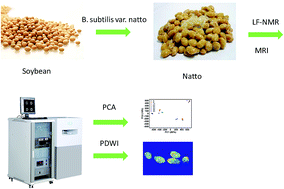Monitoring a typical fermentation process of natto by low-field nuclear magnetic resonance (LF-NMR) and magnetic resonance imaging (MRI) techniques
Abstract
Natto is a typical fermented food, and bears various health benefits. Its production involves complex biochemical processes and requires versatile monitoring techniques. In this work, LF-NMR and MRI techniques were introduced to monitor a typical fermentation process of natto. Upon a multi-exponential fitting of NMR data obtained by using a Carr-Purcell-Meiboom-Gill (CPMG) pulse sequence, spin–spin relaxation time (T2) spectra display the presence of four populations of water molecules during the fermentation: bound water (T2,1), immobilized water (T2,2), moderately immobilized water (T2,3) and free water (T2,4). The concomitant increase in apparent physicochemical properties and the T2,3 water populations can be correlated with the extended fermentation time. The chemometric method of principal component analysis (PCA) based on the CPMG data further reveals that the fermentation is characteristic of a process with three main phases. On the other hand, the proton density weighted images, derived from MRI, reveal the spatial distribution of water molecules within the fermented products and project a full hydration process inside natto through a gradual penetration of water molecules from the edge to the center of the granules. Therefore, LF-NMR and MRI combined with chemometrics provide unique insights into the monitoring of natto fermentation.


 Please wait while we load your content...
Please wait while we load your content...